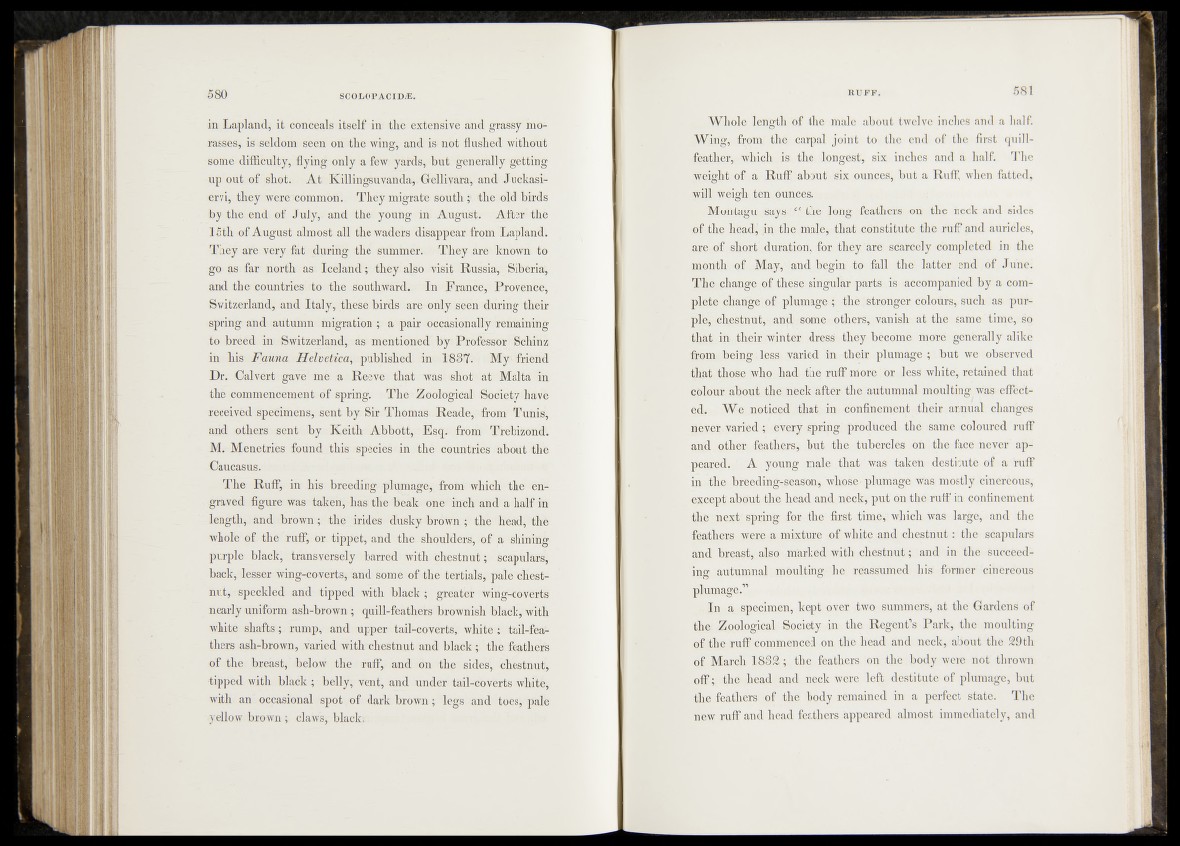
in Lapland; it conceals itself in* the extensive and grassy morasses,
is seldom seen on the wing, and is- not flushed without
some difficulty, flying only a few.' yards, but generally getting
up out of shot.. At Killkigsuvanday Gttivara, and; Juokasi-
ervi, they were'common. They migrate south £ «the old birds
by the ends of July,> and the*: yöüng in; August. After' thé
15th of August almost all the waders disappear from Lapland.
They are very, fat during thé summer. They .are known to
go- as: far north as Iceland; they also visit Russia,' Siberia;
and the countries to the southward* In Prance’, ■ Provence,
Switzerland} and Italy, these birds are only-"seen during their
spring and autumn migration 5 a pair 'occasionally remaining
to breed in Switzerland, as mentioned' by’ Professor - Schinz
in his Fauna Helvetica, .published in 183^.-< 1 My''friend
Dr. Calvert gave' mé a Reeve that- was^boh at Malta in
the commencement óf spring. ; The-- Zoological Societyhavë
received .specimens, sent by Sir Thomas Reade,—from Tunis,
aiid others sent by Keith A b b o tt, Esq.-from Trebizond.
M. Menetries found this species in the countries about the
Caucasus.
The Ruff, in his breeding-plqmage, from which the engraved
figure was taken, has the beak onerirch and a half in
length, and:rbrown; the irides dusky brown ; the head j thé
whole* of. the ruff, or. tippet, and the. shoulder's, b f a shining
purple black, transversely barred with cbestnut; scapulars,
back, lesser wing-coverts^ and some of the tertials, pale chestnut,
- speckled and tipped with black; greater wing-coverts
nearly uniform ash-brown; quill-feathers brownish blacky with
white shafts; rump, and upper tail-coverts, white; tail-feathers
ash-brown, varied with-chestnut and black; the feathers
of the. breast/below the ruff, and on the sides, chestnut,
•tipped with black ; belly, vent, and under tail-coverts white,
with an occasional spot. of dark brown; legs and toes, pale
■yellow brown; claws, blacks.
Whole length of the male about twelve inches and a half.
Wing, from the carpal joint to the end of the first quill-
feather,; which is the longest', six inches and a half. The
weight, of a Ruff about six ounces, but a Ruff, when fatted,
will weigh ten ounces, tajj
Montagu says. “ the long feathers on the neck and sides
of . the head,’ jn the male, that constitute the ruff and auricles,
are of short duration', for they are scarcely completed in the
month»* of May, an dj,begin! to fall the latter, end of June.
The, change o|.fthe.se singular parts is accompanied by a complete
change of plumage ; ■ -the ; stronger colours, such as pur-
pley chestnut, and some -others, vanish- at the same time, sq
that in^thjeir. winter dress' they become more generally alike
from being;less, varied in their plumage ; but we observed
that those who had the ruff more or less white, retained that
colour, about the neck after the autumnal moulting was effected.
We noticed that in confinement their annual changes
Ueyer,.varied | every spring! produced the same coloured ruff
and other feathers, but the>??itubercles on the face never appeared.
' A young male that was taken destitute of a ruff
in the breeding-seaSOn, whose* plumage was mostly cinereous,
except about the head and neck, put on the ruff in confinement
the next spring for the first time; which was large, and the
feathers were a mixture of white and chestnut: the scapulars
and breast, also marked with chestnut; and in the succeeding
autumnal moulting he reassumed O 0 his former cinereous
plumage.”
In a specimen, kept over two summers, at the Gardens of
the Zoological' Society in the Regent’s Park, the moulting
of the ruff commenced on the head and neck, about the 29th
of March 1832; the. feathers on the body were not thrown
off; the- head and neck were left destitute of plumage, but
the feathers of the body remained in a perfect state. The
new ruff and head feathers appeared almost immediately, and